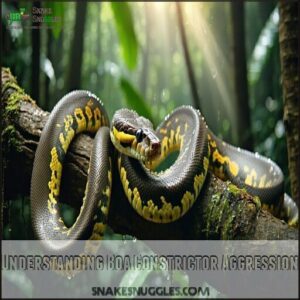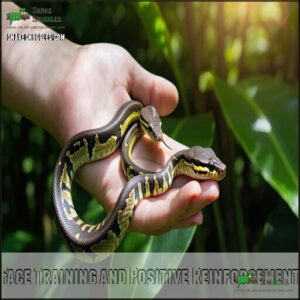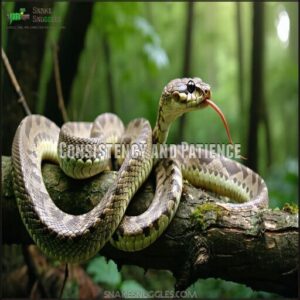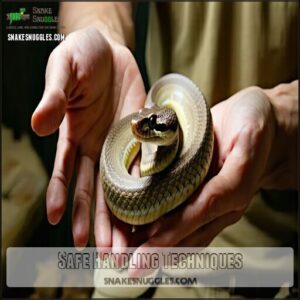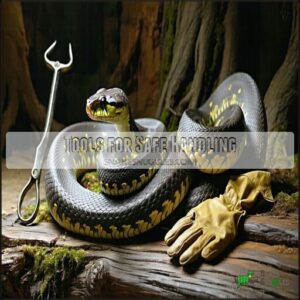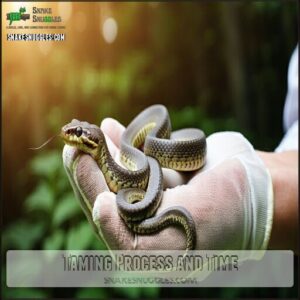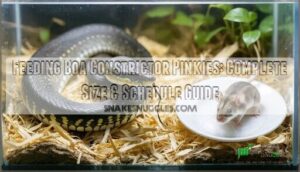This site is supported by our readers. We may earn a commission, at no cost to you, if you purchase through links.
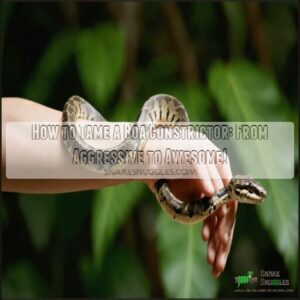 Want to tame a boa constrictor? It’s not for the faint of heart!
Want to tame a boa constrictor? It’s not for the faint of heart!
First, understand that these serpentine companions require patience and respect. Start by creating a stress-free environment and approach them slowly, letting them get used to your presence.
Always support their body when handling and move with calm, deliberate motions. Use consistent, gentle interactions to build trust—snakes aren’t cuddle buddies, but they can learn to tolerate handling.
Avoid sudden movements, speak softly, and never grab them unexpectedly. Remember, taming a boa constrictor is about mutual understanding and creating a positive experience for both of you.
Ready to become a snake whisperer?
Table Of Contents
- Key Takeaways
- Understanding Boa Constrictor Aggression
- How to Tame a Boa Constrictor
- Safe Handling Techniques
- Environmental Care
- Tools for Safe Handling
- Taming Process and Time
- Frequently Asked Questions (FAQs)
- How do you tame a boa constrictor?
- Do boa constrictors like to be held?
- How do you tame a boa?
- How do you take care of a boa constrictor?
- Do boa constrictors need enrichment?
- How do you know if a boa constrictor is healthy?
- Can you domesticate a boa constrictor?
- How do you calm down a snake?
- How long does it take to tame a snake?
- Can boa constrictors bond with multiple owners?
- Conclusion
Key Takeaways
- You’ll need patience and consistency when taming a boa constrictor. Start with short, calm handling sessions and gradually build trust by moving slowly and supporting the snake’s entire body, avoiding sudden movements that could trigger defensive behaviors.
- Your boa’s environment is crucial to successful taming. Create a stress-free habitat with proper temperature, humidity, and multiple hiding spots that’ll help your snake feel secure and reduce aggressive tendencies.
- Learn to read your snake’s body language carefully. Watch for warning signs like hissing, coiling, or color changes that indicate stress, and respect the snake’s boundaries to prevent defensive reactions and build a cooperative relationship.
- Handling tools like snake hooks and feeding tongs are essential for safe interaction. They’ll help you maintain a safe distance, guide your snake without direct contact, and minimize the risk of accidental bites while building trust and confidence.
Understanding Boa Constrictor Aggression
If you’ve ever felt like your boa constrictor is more "hiss" than "hugs," you’re not alone in the wild world of snake handling.
Understanding your snake’s aggressive behavior is the first step to transforming your scaly friend from a defensive dynamo to a calm, cool companion.
Common Signs of Aggression
Watch out for your boa’s mood signals! When feeling threatened, these slithery friends might hiss, strike defensively, or coil into a tight ‘S’ posture.
Mouth gaping and stress-induced color changes are key warning signs. Recognizing these defensive behaviors helps you understand your boa’s temperament and avoid potential aggressive encounters.
Stay alert and read their body language carefully. Always guarantee proper support for handling to help your boa feel secure and reduce stress.
Causes of Aggressive Behavior
Most boa constrictors aren’t naturally aggressive, but several key factors can trigger defensive behaviors.
Beneath their scales, boa constrictors are more gentle souls than fierce predators—just misunderstood reptilian friends waiting to be understood.
Mishandling and stressful environments often push these reptiles into aggressive modes.
Health issues, genetic predispositions, and prior trauma can dramatically influence snake behavior.
When your boa feels threatened, cornered, or uncomfortable, it’ll likely display aggressive tendencies as a survival mechanism.
Understanding signs of aggression in boa constrictors can help in identifying and addressing these behaviors effectively.
How to Tame a Boa Constrictor
Ready to transform your aggressive boa constrictor into a calm, handleable companion?
Taming a boa isn’t magic—it’s about patience, trust-building, and understanding your snake’s unique personality.
You’ll learn how to turn those defensive hisses into peaceful interactions.
Gradual Handling and Building Trust
With patience and skill, you’ll transform your initially defensive boa into a calm companion through gradual handling techniques. Trust-building requires careful, strategic approaches:
1. Start with brief, non-invasive proximity sessions:
- Move slowly and predictably near the enclosure.
- Allow the snake to observe you without direct interaction.
2. Consistent, gentle exposure:
Helps your snake become comfortable with your presence.
It’s also important to recognize defensive behaviors in boas such as coiling or hissing to mitigate stress during taming.
Face Training and Positive Reinforcement
Building on your initial trust, face training transforms your relationship with your boa.
Eye Contact Desensitization helps your snake recognize you’re not a threat. Use gentle, calm interaction techniques that encourage exploration.
Reward-Based Handling with small treats during trust-building exercises signals safety. Your steady presence teaches the snake you’re a friend, not food—gradually turning potential aggression into mutual understanding.
Consistency and Patience
After mastering face training, your snake-taming journey hinges on consistency.
Stick to a Regular Handling Routine that builds trust and predictability.
Here’s your roadmap:
- Schedule daily interaction windows2. Maintain Consistent Behavioral Cues
- Practice Patience With Progress4. Respect the snake’s individual learning paceYour commitment transforms an initially defensive snake into a calm, cooperative companion through trust-building techniques.
Safe Handling Techniques
Mastering safe handling techniques for a boa constrictor isn’t just about avoiding a bite—it’s about building trust and respect.
You’ll want to approach your snake slowly, support its body fully, and learn to read its mood, turning those potentially scary moments into awesome bonding experiences.
Slow and Calm Approach
When handling a boa constrictor, your approach can make or break the interaction.
Slow, deliberate movements are your secret weapon for success. Think of yourself as a snake whisperer—calm and calculated.
Slither softly, move with purpose—your snake will sense your calm confidence.
Watch the snake’s body language closely, and let your hand movements be gentle and predictable.By approaching without sudden jerks or loud noises, you’ll help the snake feel secure and less defensive.
Supporting The Snake’s Body
Because snakes aren’t fan-friendly pets, supporting a boa constrictor’s body correctly is indispensable. Here’s how to provide full-body support:
- Distribute weight evenly along the snake’s length.
- Use both hands to create a balanced handling grip.
- Avoid gripping too tightly or too loosely.
- Support the snake’s entire body, not just segments.
- Keep the snake’s body horizontal during lifting.
Proper techniques prevent body strain and build snake confidence.
Avoiding Triggers
When taming a boa constrictor, knowing what sets them off is your secret weapon.
Reduce loud noises and sudden movements that can trigger their stress response. Learn to read snake behavior triggers like rapid breathing or coiling posture.
By identifying and managing stressors effectively, you’ll create a calm interaction environment that helps your snake feel secure.
Environmental Care
Creating a stress-free home for your boa constrictor isn’t just about fancy decor—it’s about understanding their basic survival needs.
You’ll want to craft an environment that feels like a five-star snake resort, complete with perfect humidity, temperature-controlled zones, and plenty of hiding spots that’ll make your scaly friend feel safe and secure.
Stress-Free Environment
In your boa constrictor’s world, creating a stress-free environment is key to transforming aggression into calm.
Here’s how to design the perfect snake sanctuary:
- Maintain consistent temperature and humidity levels.
- Provide multiple hiding spots throughout the enclosure.
- Minimize sudden environmental changes that might trigger defensive behaviors.
Incorporating features like proper ventilation and airflow can also help reduce stress and establish a healthier enclosure environment.
Your snake will thank you with reduced stress and improved trust.
Feeding and Hygiene Practices
After creating a stress-free habitat, smart feeding practices keep your boa happy and healthy.
Use feeding tongs to minimize direct contact, preventing accidental bites. Always wash your hands before and after handling food or your snake to prevent contamination.
Specialized reptile feeding equipment can also aid in maintaining proper hygiene and safety during feeding.
Consult a reptile veterinarian to establish an ideal feeding schedule that matches your boa’s age and size.
Respecting The Snake’s Boundaries
Behind every successful snake interaction lies respect for personal space.
Understanding your boa’s boundaries is indispensable for building trust and preventing stress. Consider these key points for respectful interaction:
- Learn to read subtle body language2. Recognize when your snake needs alone time3. Never force handling during vulnerable momentsPatience transforms your relationship from confrontational to cooperative, making taming a rewarding journey.
Tools for Safe Handling
When handling a boa constrictor, you’ll want to arm yourself with the right tools to keep both you and your scaly friend safe.
A snake hook, feeding tongs, and protective gloves aren’t just accessories—they’re your secret weapons for turning a potentially tense encounter into a smooth, stress-free interaction.
Using a Snake Hook
When maintaining your boa’s environment, a snake hook becomes your trusty sidekick for safe handling.
Proper hook positioning lets you guide your nervous snake without direct contact, giving you control and confidence. It’s like having a magic wand that helps you communicate boundaries and manage your boa’s movements, making handling smoother and less stressful for both of you.
For additional safety, consider learning about safe snake handling techniques to guarantee a secure interaction.
Snake hook, proper hook positioning, communicate boundaries, and safe snake handling techniques are key concepts to ensure a safe environment for both you and your boa.
Feeding Tongs and Other Tools
After mastering the snake hook, you’ll want reliable feeding assistance tools.
Feeding tongs become your best friend when handling boa constrictors. These long, precise tools help you maintain a safe distance during meals, preventing accidental bites.
Choose stainless steel tongs with smooth edges, and always clean them between uses to guarantee your snake’s health and your safety.
Many keepers rely on stainless steel tongs for both their durability and ease of cleaning.
Taming Process and Time
How long will it take to tame your boa constrictor? The snake taming process isn’t a one-size-fits-all journey. Trust-building strategies depend on your individual snake’s temperament and past experiences.
Key aspects of desensitization steps include:
- Consistent daily interaction routines Gradual handling with patience Monitoring behavioral progress indicatorsMost boas require 3-6 months of dedicated training to become comfortable with human interaction. Some snakes adapt quickly, while others need more time to develop trust.Remember that each snake has a unique personality, so your approach must be flexible. Aim for short, positive handling sessions that gradually increase in duration.Pay attention to your snake’s body language and comfort level, adjusting your taming techniques accordingly.
You can also learn from handling techniques for snakes to improve your approach and guarantee successful taming.
Frequently Asked Questions (FAQs)
How do you tame a boa constrictor?
Scientists debate snake temperament, but here’s the scoop: start slow, build trust gradually.Handle your boa gently, respect its space, and use positive reinforcement.Patience and consistent, calm interactions will help transform your snake’s behavior.
Do boa constrictors like to be held?
Boa constrictors aren’t cuddly pets, but they’ll tolerate handling if you’re patient.
Approach slowly, support their body, and build trust gradually.
They’ll warm up to you if you respect their boundaries and move with calm, deliberate movements.
How do you tame a boa?
Learn your boa’s body language and respect its boundaries.
Start with slow, gentle interactions, build trust gradually, and create a calm environment.
Always handle with care, patience, and consistent, positive reinforcement techniques.
How do you take care of a boa constrictor?
Picture taming a wild spirit: your boa needs a sanctuary of comfort.
Maintain precise temperature, humidity, and diet. Handle gently, respect boundaries.
Create trust through consistent, calm interactions. Prioritize safety and understanding for a harmonious relationship.
Do boa constrictors need enrichment?
You’ll definitely need to provide enrichment for your boa constrictor.
It’ll help prevent boredom, reduce stress, and stimulate natural behaviors like exploring, climbing, and problem-solving through varied terrain and interactive elements in its habitat.
How do you know if a boa constrictor is healthy?
Like a detective reading critical signs, you’ll spot a healthy boa by its clear eyes, vibrant scales, consistent feeding, smooth shedding, active behavior, and normal breathing without wheezing or mouth gaping.
Can you domesticate a boa constrictor?
You can’t fully domesticate a boa constrictor, but you’ll make progress by building trust through gradual, patient handling.
Respect their wild nature, learn their behaviors, and create a stress-free environment for safer interactions.
How do you calm down a snake?
Breathe softly, move like a gentle breeze near your snake.
Stay calm and still, letting the reptile sense your peaceful energy.
Speak in low tones, avoiding sudden movements that might startle your slithery friend.
How long does it take to tame a snake?
You’ll need patience—taming a boa constrictor takes about6-12 months of consistent, gentle handling.
Start with short sessions, respect the snake’s boundaries, and build trust gradually through calm, predictable interactions.
Taming a boa constrictor and gentle handling are key to the process.
Can boa constrictors bond with multiple owners?
Uncoiling the threads of companionship, boa constrictors can adapt to multiple owners if introduced gradually.
You’ll need patience, consistent handling, and respect for their unique temperament to forge lasting bonds with these remarkable reptiles.
Conclusion
Ultimately, taming a boa constrictor isn’t about domination—it’s about building a bond of mutual respect.
You’ll transform from a nervous handler to a confident snake whisperer by mastering patience, understanding body language, and consistently practicing gentle interactions.
Remember, how to tame a boa constrictor requires dedication, calm energy, and genuine commitment.
Your reward? A remarkable companion who trusts you completely, proving that even the most intimidating reptiles can become incredible partners with the right approach.
- https://www.redtailboas.com/forum/boa-general-care-husbandry/boa-care/1597-tips-on-how-to-tame-my-boa
- https://www.reptileforums.co.uk/threads/taming-new-boa.788787/
- https://ourreptileforum.com/community/threads/boa-constrictor-baby-help-taming-asap.8107/
- https://community.morphmarket.com/t/very-defensive-baby-boa-tips/42384?page=2
- https://www.quora.com/Can-a-boa-constrictor-be-tamed-like-other-pets-such-as-dogs-and-cats

